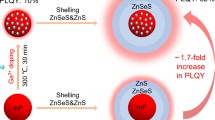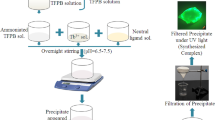Abstract
By combining two types of ligands, phenylpyridine and quinoline, a new type of organometallic IrQ(ppy)2 compound has been synthesized, which exhibits two phosphorescences: green and red. Using an appropriate catalyst, the final IrQ(ppy)2 compound has a good chemical yield up to 60% and becomes a stable dual emitter at room temperature. This compound is important because it exhibits stable red emission which is limited by the quantum yield due to the low energy band gap. As a result, an overlap between the ground state and the excited state occurs due to the vibrations that increase the nonradiative transitions, destroying the red emissions. Structural characteristics of the IrQ(ppy)2 powder reveal a triclinic structure confirmed by x-ray diffraction and scanning electron microscopy images. Thermal analysis of the final compound confirms a good stability against decomposition and structural changes up to 350 °C. X-ray photoelectron spectroscopy reveals Ir–O chemical bonds and several differences between the intermediate and final compounds, such as Ir–Cl bonds. Cathodoluminescence patterns show a phosphorescent triclinic structure with a higher efficiency for the red color. Backscattering electron images prove that there is a uniform distribution of iridium ions in the IrQ(ppy)2 nanocrystals.









Similar content being viewed by others
References
Q. Yang, Y. Hao, Z. Wang, Y. Li, H. Wang, and B. Xu: Double-emission-layer green phosphorescent OLED based on LiF-doped TPBi as electron transport layer for improving efficiency and operational lifetime. Synth. Met. 162, 398 (2012).
F.P. Rosselli, W.G. Quirino, C. Legnani, V.L. Calil, K.C. Teixeira, A.A. Leităo, R.B. Capaz, M. Cremona, and C.A. Achete: Experimental and theoretical investigation of tris-(8-hydroxy-quinolinate) aluminum (Alq3) photo degradation. Org. Electron. 10, 1417 (2009).
J. Shinar and R. Shinar: Organic light-emitting devices (OLEDs) and OLED-based chemical and biological sensors: An overview. J. Phys. D: Appl. Phys. 41, 133001 (2008).
C.H. Mao, J.L. Hong, and A.C. Yeh: Influence of aggregation on the phosphorescence of iridium complex in poly(methyl methacrylate) matrix. J. Polym. Sci. B 46, 631 (2008).
S. Polosan and I.C. Radu: Mechanisms of the charge transfer in IrQ(ppy)2–5Cl dual-emitter compound. J. Nanosci. Nanotechnol. 13, 5203 (2013).
S. Polosan, I.C. Radu, and T. Tsuboi: Photoluminescence and magnetic circular dichroism of IrQ(ppy)2-5Cl. J. Lumin. 132, 998 (2012).
N. Sengottuvelan, S.J. Yun, D.Y. Kim, I.H. Hwang, S.K. Kang, and Y.I. Kim: Highly efficient red emissive heteroleptic cyclometalated iridium(III) complexes bearing two substituted 2-phenylquinoxaline and one 2-pyrazinecarboxylic acid. Bull. Korean Chem. Soc. 34, 167 (2013).
N. Bera, N. Cumpustey, P.L. Burn, and I.D.W. Samuel: Highly branched phosphorescent dendrimers for efficient solution-processed organic light-emitting diodes. Adv. Funct. Mater. 17, 1149 (2007).
N. Sengottuvelan, H.J. Seo, S.K. Kang, and Y.I. Kim: Tuning photophysical and electrochemical properties of heteroleptic cationic iridium(III) complexes containing substituted 2-phenylquinoxaline and biimidazole. Bull. Korean Chem. Soc. 31, 2309 (2010).
N. Jung, E. Lee, J. Kim, H. Park, K.M. Park, and Y. Kang: Synthesis and crystal structure of blue phosphorescent mer-tris(2’,6’-difluoro-2,3’-bipyridinato-N,C4’)iridium(III). Bull. Korean Chem. Soc. 33, 183 (2012).
M.M. Rothmann, E. Fuchs, C. Schildknecht, N. Langer, C. Lennartz, I. Munster, and P. Strohriegl: Designing a bipolar host material for blue phosphorescent OLEDs: Phenoxy-carbazole substituted triazine. Org. Electron. 12, 1192 (2011).
D.F. Huang, T.J. Chow, C.Y. Wu, S.S. Sun, S.H. Tsai, Y.S. Wen, S. Polosan, and T. Tsuboi: The preparation of (8-hydroxyquinolinato)bis(2-phenylpyridyl)iridium complexes and their photophysical properties. J. Chin. Chem. Soc. 55, 439 (2008).
C. Yi, C.J. Yang, J. Liu, M. Xu, J.H. Wang, Q.Y. Cao, and X.C. Gao: Red to near-infrared electrophosphorescence from an iridium complex coordinated with 2-phenylpyridine and 8-hydroxyquinoline. Inorg. Chim. Acta 360, 3493 (2007).
W.A. Rachinger: A correction for the α1 α2 doublet in the measurement of widths of x-ray diffraction lines. J. Sci. Instrum. 25, 254 (1948).
T. Laetsch and R. Downs: Software for identification and refinement of cell parameters from powder diffraction data of minerals using the RRUFF project and American Mineralogist Crystal Structure Databases. Abstracts from the 19th General Meeting of the International Mineralogical Association, Kobe, Japan, 23–28 July (2006).
J. Lee, K.M. Park, K. Yang, and Y. Kang: Blue phosphorescent Ir(III) complex with high color purity: fac-tris(2′,6′-difluoro-2,3′-bipyridinato-N,C4′)iridium(III). Inorg. Chem. 48, 1030 (2009).
C.D. Wagner, W.M. Riggs, L.E. Davis, and J.F. Moulder: Handbook of X-ray Photoelectron Spectroscopy, G.E. Muilenberg ed.; Perkin Elmer, Physical Electronics Division: Eden Prairie, MN, 1978.
B.D. El-Issa, A. Katrib, R. Ghodsian, B.A. Salsa, and S.H. Addassi: A comparative study of the bonding in different halides of iridium. Int. J. Quantum Chem. 33, 195 (1988).
L. Atanasoska, R. Atanasoska, and S. Trassati: XPS and AES study of mixed layers of RuO2 and IrO2. Vaccum 40, 91 (1990).
L. Atanasoska, P. Gupta, C. Deng, R. Warner, S. Larson, and J. Thompson: XPS, AES, and electrochemical study of iridium oxide coating materials for cardiovascular stent application. ECS Trans. 16, 37 (2009).
F.J. García de Abajo: Optical excitations in electron microscopy. Rev. Mod. Phys. 82, 209 (2010).
I.C. Radu, S. Polosan, I. Enculescu, and H. Iovu: Cathodoluminescence and Raman analysis of the finite-size effects in mer-Alq3 structure. Opt. Mater. 35, 268 (2012).
ACKNOWLEDGMENT
This work was supported by a grant of the Romanian National Authority for Scientific Research, CNCS-UEFISCDI, project number PN-II-ID-PCE-2011-3-0620.
Author information
Authors and Affiliations
Corresponding author
Rights and permissions
About this article
Cite this article
Polosan, S., Ciobotaru, I.C., Enculescu, I. et al. Structural characteristics of iridium dual-emitter organometallic compound. Journal of Materials Research 29, 2898–2904 (2014). https://doi.org/10.1557/jmr.2014.337
Received:
Accepted:
Published:
Issue Date:
DOI: https://doi.org/10.1557/jmr.2014.337




